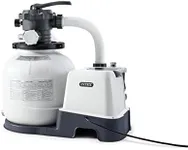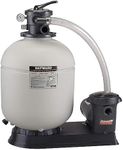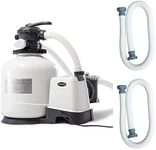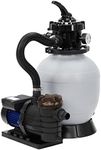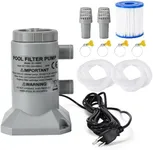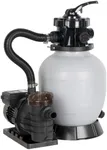Buying Guide for the Best Sand Filters
Choosing the right sand filter for your pool is crucial to maintaining clean and clear water. Sand filters are popular because they are effective, easy to maintain, and relatively affordable. When selecting a sand filter, it's important to consider several key specifications to ensure you get the best fit for your pool's needs. Understanding these specifications will help you make an informed decision and keep your pool in top condition.Filter SizeThe filter size refers to the diameter of the filter tank and is crucial because it determines the filter's capacity to handle the volume of water in your pool. A larger filter can handle more water and debris, making it suitable for bigger pools. For small to medium-sized pools, a filter with a diameter of 16-20 inches is usually sufficient. For larger pools, you might need a filter with a diameter of 24 inches or more. To pick the right size, consider the volume of your pool and the flow rate of your pump. A filter that is too small will require more frequent cleaning and may not effectively keep your pool clean.
Flow RateThe flow rate is the amount of water that can pass through the filter per minute, usually measured in gallons per minute (GPM). This spec is important because it needs to match the flow rate of your pool pump to ensure efficient filtration. If the flow rate of the filter is too low, it won't be able to keep up with the pump, leading to poor filtration. Conversely, if it's too high, it can cause excessive wear on the filter. For small pools, a flow rate of 30-50 GPM is typically adequate. For larger pools, look for a flow rate of 60-100 GPM. Match the flow rate to your pump's output for optimal performance.
Filter MediaThe filter media is the material inside the filter that traps debris and particles. In sand filters, this is typically high-grade silica sand. The quality and type of sand can affect the filter's efficiency. Standard pool filter sand is usually sufficient for most pools, but some filters can use alternative media like glass or zeolite, which can offer better filtration and longer life. When choosing the filter media, consider the type of debris common in your pool and the level of filtration you desire. Higher quality media can provide finer filtration and reduce the frequency of backwashing.
Valve TypeThe valve type on a sand filter controls the flow of water through the filter and is important for maintenance and operation. The most common types are multiport valves and slide valves. Multiport valves offer multiple settings, including filter, backwash, rinse, waste, recirculate, and closed, making them versatile and easy to use. Slide valves are simpler, with just two positions: filter and backwash. If you prefer more control and ease of use, a multiport valve is a better choice. For simplicity and fewer moving parts, a slide valve might be sufficient. Consider how often you will need to backwash and maintain the filter when choosing the valve type.
Durability and MaterialThe durability and material of the filter tank are important for the longevity and reliability of the filter. Most sand filter tanks are made from high-density polyethylene or fiberglass, which are resistant to corrosion and UV damage. A durable tank will withstand the elements and the pressure of the water, reducing the risk of leaks and cracks. When choosing a filter, look for one with a robust construction and a good warranty. If your pool is in an area with harsh weather conditions, opt for a filter made from materials that can withstand those conditions. Durability ensures that your investment will last for many years with minimal issues.
